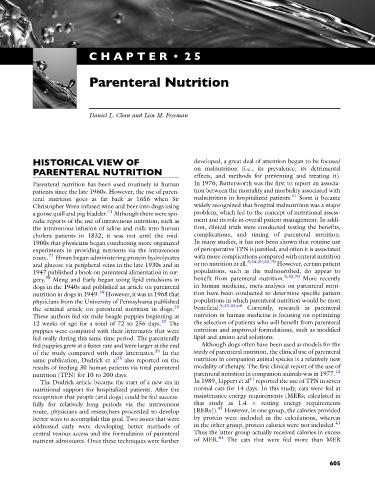Page 617 - Fluid, Electrolyte, and Acid-Base Disorders in Small Animal Practice
P. 617
CHAPTER • 25
Parenteral Nutrition
Daniel L. Chan and Lisa M. Freeman
HISTORICAL VIEW OF developed, a great deal of attention began to be focused
PARENTERAL NUTRITION on malnutrition (i.e., its prevalence, its detrimental
effects, and methods for preventing and treating it).
Parenteral nutrition has been used routinely in human In 1976, Butterworth was the first to report an associa-
patients since the late 1960s. However, the use of paren- tion between the mortality and morbidity associated with
11
teral nutrition goes as far back as 1656 when Sir malnutrition in hospitalized patients. Soon it became
Christopher Wren infused wine and beer into dogs using widely recognized that hospital malnutrition was a major
71
a goose quill and pig bladder. Although there were spo- problem, which led to the concept of nutritional assess-
radic reports of the use of intravenous nutrition, such as ment and its role in overall patient management. In addi-
the intravenous infusion of saline and milk into human tion, clinical trials were conducted testing the benefits,
cholera patients in 1832, it was not until the mid- complications, and timing of parenteral nutrition.
1900s that physicians began conducting more organized In many studies, it has not been shown that routine use
experiments in providing nutrients via the intravenous of perioperative TPN is justified, and often it is associated
route. 71 Elman began administering protein hydrolysates with more complications compared with enteral nutrition
8,24,29,32,70
and glucose via peripheral veins in the late 1930s and in or no nutrition at all. However, certain patient
1947 published a book on parenteral alimentation in sur- populations, such as the malnourished, do appear to
8,32,70
gery. 38 Meng and Early began using lipid emulsions in benefit from parenteral nutrition. More recently
dogs in the 1940s and published an article on parenteral in human medicine, meta-analyses on parenteral nutri-
nutrition in dogs in 1949. 38 However, it was in 1968 that tion have been conducted to determine specific patient
physicians from the University of Pennsylvania published populations in which parenteral nutrition would be most
8,29,32,64
the seminal article on parenteral nutrition in dogs. 25 beneficial. Currently, research in parenteral
These authors fed six male beagle puppies beginning at nutrition in human medicine is focusing on optimizing
12 weeks of age for a total of 72 to 256 days. 25 The the selection of patients who will benefit from parenteral
puppies were compared with their littermates that were nutrition and improved formulations, such as modified
fed orally during this same time period. The parenterally lipid and amino acid solutions.
fed puppies grew at a faster rate and were larger at the end Although dogs often have been used as models for the
of the study compared with their littermates. 25 In the study of parenteral nutrition, the clinical use of parenteral
same publication, Dudrick et al 25 also reported on the nutrition in companion animal species is a relatively new
results of feeding 30 human patients via total parenteral modality of therapy. The first clinical report of the use of
12
nutrition (TPN) for 10 to 200 days. parenteral nutrition in companion animals was in 1977.
41
The Dudrick article became the start of a new era in In 1989, Lippert et al reported the use of TPN in seven
nutritional support for hospitalized patients. After the normal cats for 14 days. In this study, cats were fed at
recognition that people (and dogs) could be fed success- maintenance energy requirements (MERs; calculated in
fully for relatively long periods via the intravenous that study as 1.4 resting energy requirements
41
route, physicians and researchers proceeded to develop [RERs]). However, in one group, the calories provided
better ways to accomplish this goal. Two issues that were by protein were included in the calculations, whereas
41
addressed early were developing better methods of in the other group, protein calories were not included.
central venous access and the formulation of parenteral Thus the latter group actually received calories in excess
41
nutrient admixtures. Once these techniques were further of MER. The cats that were fed more than MER
605

